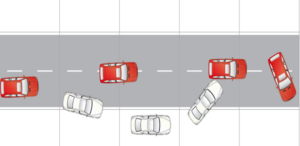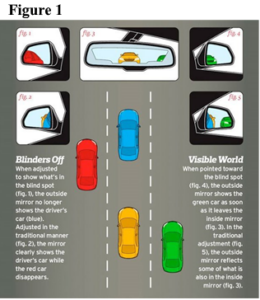By Todd Duncan, Law Enforcement and Safety Specialist
It’s a clear, crisp fall morning, and you just started your shift. You’re trying out the new moving radar unit that was recently installed in your patrol vehicle as you cruise down the two-lane black top highway with a posted 65 MPH speed limit. Within minutes, you see an oncoming vehicle approaching at what appears to be a high rate of speed. You activate your radar and immediately confirm your suspicion as the radar begins to screech and the dash mounted display flashes “87”.
As the oncoming car speeds by you, you begin a U-turn maneuver that you have done a thousand times before – brake, pull partially onto the right shoulder to expand your turning radius, a quick mirror check, and begin the U-turn so you can chase down the violator. Unbeknownst to you, a red SUV following you at 65 MPH is now proceeding past you on the left in your blind spot as you’re pulling onto the shoulder. They have no idea you are about to do a sudden U-turn. As you begin the U-turn, the left front corner of your patrol vehicle collides violently with the passenger side of the SUV that seemingly “came out of nowhere”. You are thrown violently around the cockpit upon impact as the SUV slides sideways in front of you before it begins to roll multiple times. You notify dispatch, crawl out of your damaged patrol car, and run to the upside-down vehicle in the ditch to check on the occupants. You find two people inside with life-threatening injuries and immediately request EMS.
Sadly, NIRMA law enforcement members are involved in this type of U-turn crash all too often, and the sequence of events (depicted in the below diagram) is usually the same – a patrol car passes an oncoming motorist who is violating a traffic law; the patrol vehicle (white car) quickly decelerates while simultaneously pulling onto the right shoulder to expand its turning radius; a motorist in a third vehicle (red car) is following behind the patrol vehicle and drifts to the left in an effort to go around the patrol vehicle that appears to be pulling off to the side of the road to stop; and the patrol vehicle changes course suddenly to execute a U-turn colliding with the passenger side of the passing vehicle.
U-turn collisions, sequence of events:
The physics of these specific U-turn collisions are similar to tactical vehicle interventions (TVIs) or pursuit intervention technique (PIT) maneuvers performed at high speeds which we know often result in serious injury or death. NIRMA has seen numerous patrol vehicle U-turn crashes like this that have resulted in life threatening injuries and in some cases, losses exceeding $300,000. Particularly concerning is the potential for serious injury or death to officers should the collision involve a high-speed broadside impact to the driver’s door of the patrol vehicle. It is easy to see how these collisions occur, as officers in these situations are processing a lot of information in a short amount of time as they are negotiating the U-turn and attempting to apprehend the violator. At the same time, the driver of the trailing vehicle understandably thinks the officer is pulling onto the shoulder to stop and drifts into the officer’s blind spot to create space as they attempt to go around the patrol vehicle.

The good news is these crashes are almost always preventable. The first step is to raise awareness with personnel about the dangers of these specific U-turn maneuvers and when they most often occur, i.e. making U-turns to catch up to a wanted person, vehicle, or traffic violator traveling in the opposite direction.
Another concrete step agencies can take to reduce the likelihood of these crashes is to include these U-turn maneuvers in annual pursuit and emergency vehicle operation training. Training should highlight the danger of this specific maneuver and provide steps that can be taken to prevent these collisions such as activating overhead emergency lights and left turn signal to alert motorists; double-checking mirrors; and quickly glancing over the left shoulder before initiating the turn.
Regarding mirrors, proper adjustment of outside rearview mirrors can significantly reduce blind spots which are a major contributing factor in these types of collisions. According to a study by the Society for Automotive Engineers (SAE), “A vehicle can be easily hidden in the blind zones created by setting the outside rearview mirrors to just see the side of the car” as is often the recommendation found in vehicle owner’s manuals. The SAE study goes on to say that “Blind zones can be effectively eliminated if the outside rearview mirror’s viewing angles are turned outward away from the side of the car.” The diagram taken from Car and Driver (Figure 1) illustrates this nicely.

It takes some time to get used to having your mirrors positioned as recommended in Figure 1, but it makes a big difference in reducing blind spots thereby reducing your chances of a collision.
Performing sudden U-turns after passing a violator or wanted person traveling in the opposite direction is a common task that presents significant risk. Raising awareness within your agency through training, including mirror positioning, can go a long way towards preventing these often devastating and costly collisions, thereby achieving what matters most to our members – ensuring the safety of everyone involved while saving tax dollars.

